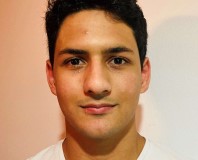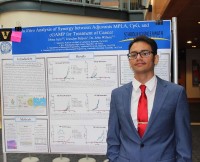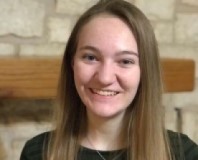REU Past Students
2022 2021 2019 2018 2017 2016 2015 2014 2013 2012 2011
2021
-
Thiago Arnaud - Mechanical Engineering, Florida International University
 LinkedIn
LinkedIn
Educational Institution: Florida International University
List of Mentors: Dr. Josh Caldwell & Minghe He
Program: NSF REU
Research Project: Multi-spectral Thermal Imaging with Inversely Designed Optical Filters for Material Recognition
Poster: NSF REU Thiago Arnaud Poster
Research Abstract: Thermal radiation describes the emission of electromagnetic waves from an object whose temperature is above absolute zero. Thermal emission for objects near or just above room temperature are typically peaked at wavelengths within the long-wave-infrared (7 μm-14 μm wavelengths). This allows for the possibility of thermal imaging, the visualization of the thermally emitted infrared light from objects. A blackbody is one that thermally emits a broadband of infrared and potentially visible and ultraviolet light that is mathematically defined by Planck’s Blackbody Radiation Law. A graybody is an object that still follows this same mathematical function but is scaled to a lower emitted power by the object’s emissivity characteristic. Thus, by assuming objects within a thermal image are graybodies, this concept can be used to approximate the temperature of the objects by correlating it to the emitted power using a thermal imaging camera (TIC). However, this approximation falls short for objects where the emission is not well-described by this law and for those that are highly reflective in the spectral range of interest. Thus, we have employed inversely designed, aperiodic, Distributed Bragg Reflectors (DBRs) as optical filters that serve to only transmit a defined spectral range, allowing us to directly image thermal emission, more accurately determine materials and their actual temperature. These selective spectral filters are comparable to the Red-Green-Blue (RGB) filters used in cameras for visible light. Those RGB filters have allowed for more complicated imaging and so the same is now being applied for thermal imaging.- Arnaud was awarded a $1K travel grant at the capstone poster session.
-
Mina Aziz - Biochemistry and Neuroscience, Vanderbilt University
LinkedIn

Educational Institution: Vanderbilt University
List of Mentors: Dr. John Wilson & Jessalyn Baljon, Hayden Pagendarm, Payton Stone
Program: NSF REU
Research Project: Polymersome formation via flash nanoprecipitation induces immunological activity to improve cancer immunotherapy
Poster: NSF REU Mina Aziz Poster.pdf
Research Abstract: Cancer immunotherapies, such as immune checkpoint blockade (ICB), have improved the efficacy of cancer treatments compared to conventional antitumor therapies in a subset of patients; however, there is a demonstrated limited efficacy in many patients. Utilizing innate immune agonists, such as cyclic dinucleotide (CDN) agonists for activation of stimulator of interferon genes (STING), has been demonstrated to increase antitumoral immunological response by activating and recruiting antitumor killer T-cells to the tumor site. Unfortunately, due to barriers in drug delivery – limited access to cytosolically located STING, rapid clearance, and limited cell-specific targeting – free CDN efficacy is limited. Recently, pH-responsive, polymeric nanoparticle mediated drug delivery approaches have been developed to circumvent these concerns. However, production techniques for these nanoparticles are relatively low throughput and variable, inhibiting clinical translation. Here, we utilize a high throughput flash nanoprecipitation (FNP) polymersome formulation platform to reproducibly formulate large quantities of polymeric nanoparticles. Utilizing a confined impingement jet (CIJ) mixer to facilitate nanoparticle self-assembly, we substantiate that the FNP platform results in an improvement in batch-to-batch variability, scalability, and particle size distribution, thus overcoming the previous inadequacies in polymersome formation and accelerating their clinical use.- Aziz was awarded Fan Favorite at the capstone poster session.
-
Amber Cui - Chemical Engineering, Vanderbilt University
 LinkedIn
LinkedIn
Educational Institution: Vanderbilt University
List of Mentors: Dr. Ethan Lippmann & Alex Sorets
Program: NSF REU
Research Project: Isolation of Rodent Microglia to assess Gene Silencing and Drug Targeting
Poster: NSF REU Amber Cui Poster.pdf
Research Abstract: Aging is the strongest risk factor for neurodegeneration, with a majority ofthe elderly population experiencing cognitive decline. While many factors drive disease progression, impaired microglial dysfunction has recently emerged as a common hallmark of many age-associated neurodegenerative disorders. As the resident immune cell of the central nervous system (CNS), microglia serve important functions including monitoring the CNS for pathogens and apoptotic signals. However, in disease states, chronic overactivation of microglia contributes to neurotoxicity and promotes disease progression, particularly in the context of Alzheimer’s Disease. The potential to explore microglia immunomodulation in culture is an invaluable tool to help mitigate age-associated neurodegenerative disease. We established a protocol to isolate microglia from the rodent CNS and maintain them in culture. This efficient method involves dissociating mouse brains into single cells with high viability, followed by magnetic sorting using beads coated with the antibody cd11b, a microglia-specific marker. Microglial identity was confirmed by flow cytometry for cd11b and immunostaining for iba1. Microglia were maintained in culture for up to a week and retained high viability and cellular identity. Furthermore, the magnetically sorted microglia were highly abundant with over 6,000 cells and enriched in microglia-specific markers compared to the remainder of the dissociated cell population. To demonstrate the versatility of the protocol, microglia were similarly isolated from rat brains and successfully cultured. For future work, observing phenotypic changes in microglia after siRNA-mediated gene silencing and applying therapeutics to diseased murine microglia will be explored in hopes of improving our understanding of treatments for neurodegenerative disease.- Conference Presentation
-A. Cui, A. Sorets, and E. Lippmann "Isolation of Rodent Microglia to Assess Gene Silencing and Drug Targeting" Vanderbilt Undergradaute Research Fair, Nashville, TN, September 2021.
-A. Cui, A. Sorets, and E. Lippmann "Isolation of Rodent Microglia to Assess Gene Silencing and Drug Targeting" AIChE National Annual Conference, Boston, MA, November, 2021. - Cui was awarded Best Layout at the capstone poster session.
- Conference Presentation
-
Brooke DeMarco - Biomedical Engineering, Vanderbilt University
 LinkedIn
LinkedIn
Educational Institution: Vanderbilt University
List of Mentors: Dr. Sandra Rosenthal & Ruben Torres
Program: NSF REU
Research Project: Tracking Individual Endogenous Dopamine Transporters Using Antagonist-Conjugated Quantum Dots
Poster: NSF REU Brooke DeMarco Poster.pdf
Research Abstract: The dopamine transporter (DAT) is a presynaptic transmembrane protein that drives dopamine reuptake. Abnormalities in DAT function and localization have been linked to various neuropsychiatric disorders including attention-deficit/hyperactivity disorder (ADHD), bipolar disorder (BD), and schizophrenia. Prior studies carried out in transiently transfected monolayer cell culture suggest that abnormal DAT diffusion contributes to the aforementioned disease states. Still unknown is the degree to which DAT surface diffusion is physiologically relevant in natively expressing cellular systems. Rat pheochromocytoma (PC-12) cells naturally express DAT, and upon nerve growth factor (NGF) differentiation, upregulate DAT at neurite terminals. Here, we implement a fluorescent monoamine transporter reporter, 4-(4-(dimethylamino)phenyl)-1-methylpyridinium (IDT307), to assay the presence of endogenous DAT. A significant loss in cell fluorescence using DAT and other transporter inhibitors indicates DAT presence. Using fluorescence microscopy, we apply our DAT-specific 2-β-carbomethoxy-3-β-(4 fluorophenyl)tropane (β-CFT) antagonist conjugated quantum dot (QD) probe system to track DAT in PC-12. Dynamic imaging revealed a mobile population of QD’s with an average diffusion coefficient (mean ± SEM: 0.018 ± 0.002 μm2/s) comparable to previously reported values. Our results suggest the presence of endogenously expressing DAT in PC-12 and demonstrate the utility of our antagonist-conjugated QD probe to specifically label unperturbed DAT in increasingly complex cellular environments. Insight gained from this study can be advantageous in drawing conclusions on the normal and dysfunctional diffusional behavior of DAT in native cellular architectures.- Demarco was awarded Best Use of Graphics at the capstone session.
-
Santiago Lopez - Biomedical Engineering, Virginia Commonwealth University
 LinkedIn
LinkedIn
Educational Institution: Virginia Commonwealth University
List of Mentors: Dr. Cynthia Reinhart-King & Jenna Mosier
Program: NSF REU
Research Project: Heritability of Bioenergetic Traits in Migratory Breast Cancer Cells
Poster: NSF REU Santiago Lopez Poster
Research Abstract: Metabolic heterogeneity plays a crucial role in cancer tumor expansion. Characteristics of the tumor microenvironment, like oxygen and glucose availability, contribute to the genetic diversity of the cancer cells as they have stem-like qualities. The genetic diversity in cancer cells makes the cells more likely to preferentially utilize different metabolic pathways from normal cell populations. Abnormal metabolic processes can then drive cancer cells to metastasize throughout the body. While it’s known that metabolic heterogeneity is important in metastasis, it is unknown whether this heterogeneity is passed down during cell division. ImageJ analysis and the ratiometric PercevalHR probe transduced in MDA-MB-231 breast cancer cells were used to quantify ATP:ADP ratios before and after cell division. Here, we show that there is no significant difference between the ATP:ADP ratios between the parent and daughter cells before and after cell division. Thus, bioenergetic heterogeneity is a heritable trait during cell division, providing a foundation to determine the feasibility of sorting cells based on ATP:ADP ratios. Overall, this work gives a better understanding of the bioenergetics at play in tumor migration and may point to targeted metabolic therapies for metastasis. -
Akanke Mason-Hogans - Chemical Engineering, North Carolina A&T State University
 LinkedIn
LinkedIn
Educational Institution: North Carolina A&T State UniversityUniversity
List of Mentors: Dr. Clare McCabe & Co Quach, Justin Gilmer
Program: NSF REU
Research Project: Designing Monolayer Films for Nanoscale Lubrication Using Machine Learning
Poster: NSF REU Akanke Mason-Hogans Poster.pdf
Research Abstract: Micro- and nano-scale mechanical systems often have lubrication issues that prevent them from operating at full potential. Coating device surfaces with monolayer films to lubricate them shows promise in reducing friction and wear. This project aims to more efficiently identify monolayer films that exhibit low coefficients of friction (COF) and adhesive forces (F0) and can be used to improve the lubrication of both micro- and nano-scale systems. Current evaluation methods that examine systems either by experimentation or computer simulation are impractical because of the vast design space. Our goal is to develop a large-scale screening method that performs a rapid estimation of the tribological properties of candidate monolayer coatings that differ in their terminal group chemistry and allows the examination of more potential coatings. To achieve this, using simulation data performed on a small subset of systems, we are constructing machine learning (ML) models using the random forest regressor algorithm. ML is a method of data analysis where a machine identifies patterns from a training set of data, and then uses the model developed to make predictions for unknown systems. Here, we are considering molecules retrieved from an online library of small molecules that results in ~300,000 dissimilar monolayer systems to be evaluated. After iterating through all these systems and obtaining predicted COF and F0 values, we will identify the top ~20 systems that provide the most favorable tribological properties. These candidate systems will then be simulated using molecular dynamics and traditional experimentation to confirm their properties and utility as lubricants for micro- and nano-devices.- Co-authored Journal Publications
C.D. Quach, J.B. Gilmer, D. Pert, A. Mason-Hogans, C.R. Iaovella, P.T. Cummings, and C. McCabe "High-throughput screening of tribological properties of monolayer films using molecular dynamics and machine learning" The Journal of Chemical Physics, 156, 154902 (2022).
- Co-authored Journal Publications
-
Avery Nguyen - Chemical Engineering, Massachusetts Institute of Technology
 Educational Institution: Massachusetts Institute of Technology
Educational Institution: Massachusetts Institute of Technology
List of Mentors: Dr. Greg Walker & Brad Baer
Program: NSF REU
Research Project: Predicting Raman Spectra of Group III Nitride Superlattices with Density Functional Theory
Poster: NSF REU Avery Nguyen Poster.pdf
Research Abstract: In order to understand the transport of vibrational energy in these materials, we use information from Raman spectroscopy. Utilizing density functional theory (DFT), we first calculate the Raman spectra of AlN and GaN, demonstrating the ability of simulations to accurately calculate phonon frequencies and locate Raman peaks. We then compute the Raman spectrum for the superlattice consisting of alternating unit cells of AlN and GaN. For this structure, we predict several additional Raman-active frequencies that are unique to the superlattice, indicating possible interface modes. These calculations represent new insight into the physical behavior of superlattice structures at the atomic scale. -
Addison White - Biomedical Engineering, Vanderbilt University
 LinkedIn
LinkedIn
Educational Institution: Vanderbilt University
List of Mentors: Dr. Cynthia Reinhart-King & Jenna Mosier
Program: NSF REU
Research Project: Long-Term Effect of Confinement on Cell Speed and Bioenergetics of Migratory Breast Cancer Cells
Poster: NSF REU Addison White Poster
Research Abstract: Of the yearly 9.6 million cancer-related deaths around the world, an estimated 90% are due to metastasis, or the stage at which cancer spreads from its primary location to form secondary colonies. From the primary tumor, metastatic breast cancer cells invade the surrounding extracellular matrix to reach the bloodstream. Physical properties such as stiffness, porosity, and density of the primary tumor microenvironment have previously been shown to influence both the migratory ability and internal metabolic pathways of cells confined within it. The long-term effect of cell confinement on cancer cell metabolism is largely unknown. To investigate the existence of this “metabolic memory”, collagen microtracks were formed using polydimethylsiloxane stamps to mold collagen into desired track geometries. MDA-MB-231 cells expressing the PercevalHR probe were seeded into these microtracks and the energy utilization of cells was quantified as ATP:ADP ratios as the cells migrated from confined (7 µm wide) to unconfined (15 µm wide) regions of the microtracks. ATP:ADP ratios were found to increase as cells traveled through confined regions, and ATP machinery relocalized towards the leading edge of the cell. High ATP:ADP ratios were temporarily maintained once the cells left confinement, suggesting metabolic memory may play a role in cell migration. Furthermore, the duration of this memory is directly dependent on the distance traveled in confinement, indicating that cells are conditioned by confinement. By further understanding cancer cell metabolism and its relationship to migration, specific therapeutic targets can be identified in preventing metastatic spread. -
Alessia Williams - Chemical Engineering, Prairie View A&M University
 LinkedIn
LinkedIn
Educational Institution: Prairie View A&M University
List of Mentors: Dr. Kane Jennings & Josh Passantino
Program: NSF REU
Research Project: Photoelectrochemical Polymerization of Pyrrole by Photosystem I
Poster: NSF REU Alessia Williams Poster.pdf
Research Abstract: Photosynthesis, the conversion of light energy to chemical energy, is the foundation for the sustainability of all life on Earth. One of the proteins responsible for this energy conversion is Photosystem I (PSI). Its robust reduction/oxidation capability makes it a primary candidate for enhancing solar cells with the more efficient nanotechnology found in nature. The Photosystem I protein has unique structures, namely the P700 site, that can accept electrons from a wide range of donors and the FB site that has one of the most negative reducing potentials found in nature (-0.6V vs SHE). Gel and liquid mediators have allowed electrons access to the P700 site buried within the protein through diffusion. However, we have grown a conducting polymer from the P700 site to allow for direct electron transfer. This polymer growth was accomplished by utilizing the redox capabilities of the Photosystem I protein to oxidize the pyrrole monomer to form polypyrrole. The sunlight powers the reaction, and the P700 site oxidizes the monomer, allowing it to grow and form a protein-polymer conjugate. A solution of dialyzed PSI protein, pyrrole monomer and a dopant/surfactant is exposed to sunlight to produce a protein-polymer conjugate. The characteristics of which are analyzed using gel electrophoresis, IR spectroscopy, qualitative measurements, as well as UV-Vis spectroscopy. This research aims to test multiple dopants and analyze their effect on the characteristics of the Photosystem I protein-polypyrrole conjugate.- Williams was awarded a $1K travel grant at the capstone session.
